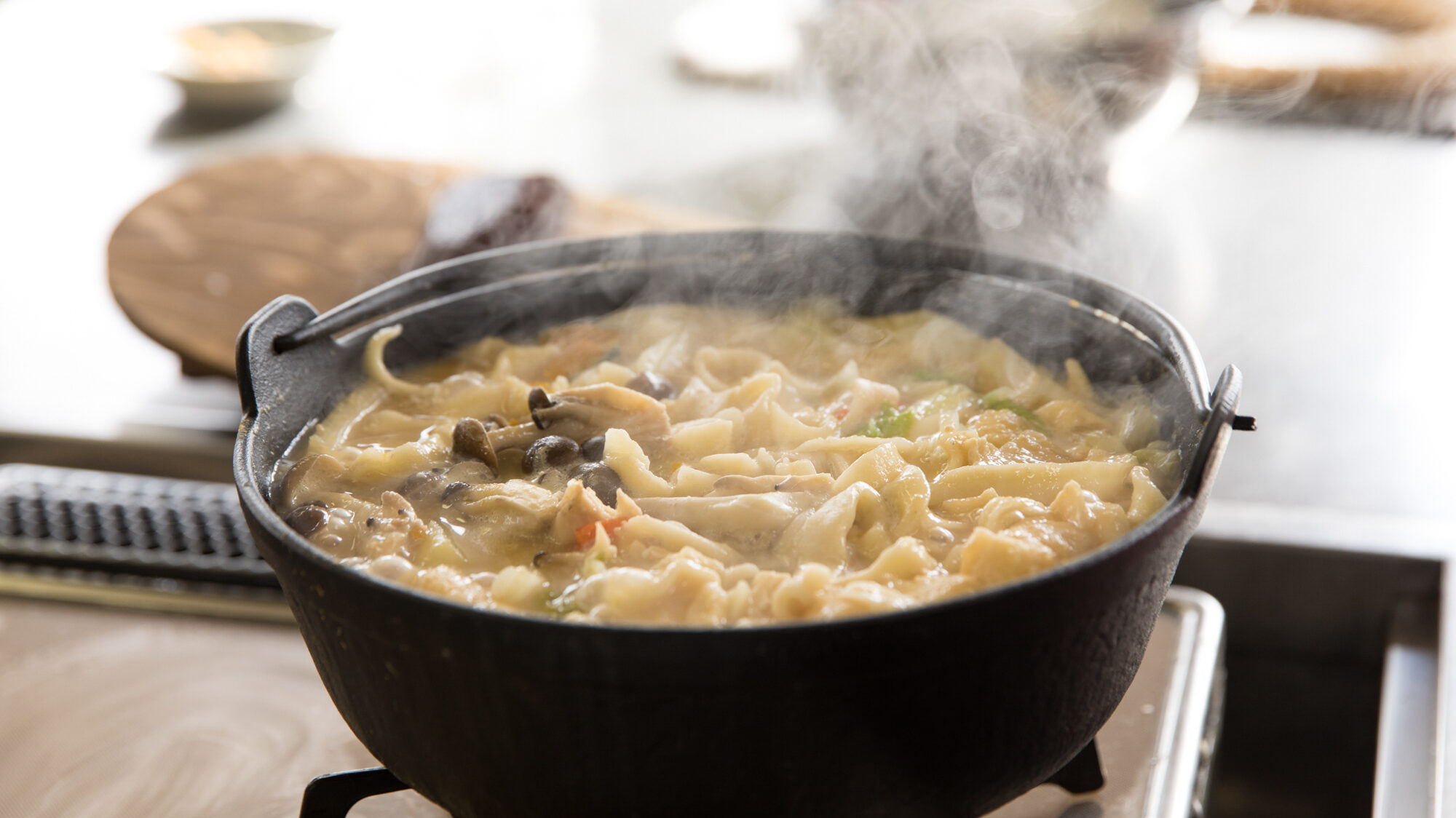
Houtou is a quintessential regional dish from Yamanashi Prefecture. It features flat, wide wheat noodles simmered in a miso-based broth with a generous amount of vegetables. It’s so well-loved that there’s even a saying: “The best thing about Yamanashi is its pumpkin houtou.” In the Kounan region, it’s also known as “Noshiire” or “Noshikomi.” Historically, it served as a staple food in the mountainous areas where rice cultivation was difficult, making noodle-making a skill traditionally associated with preparing for marriage. Since no salt is added when making the noodles, there’s no need to pre-boil them to remove excess salt. It’s an easy-to-prepare, nutritious dish that pairs wonderfully with various vegetables and meats. Interestingly, the name “Houtou” (餺飥) has roots dating back to the Heian period, when it was enjoyed by nobles during ceremonies.
Dish Name: ほうとう (Houtou)
- Region / Location: Yamanashi Prefecture, Japan
- Primary Area of Tradition: Entire prefecture
- Main Ingredients: Wheat flour, potatoes, pumpkin, daikon radish, carrots, Chinese cabbage, shiitake mushrooms, long green onions, fried tofu (aburaage), miso
How It’s Eaten / Served
To make Houtou, wheat flour is mixed with lukewarm water little by little until it forms a dough. After kneading, the dough is covered with a damp cloth and left to rest. While the dough rests, hard vegetables and mushrooms are added to a broth made from dried sardines (niboshi) and simmered until tender. The rested dough is then dusted with flour and rolled out thinly before being cut into wide noodles (houtou noodles). These noodles, along with sliced fried tofu and half the amount of miso, are added to the simmering broth. Once the noodles become translucent, the remaining miso is added to adjust the flavor. After bringing it to a boil, chopped green onions are added, the heat is turned off, and the pot is covered to let it steam for a few minutes. Meat and seasonal vegetables or mushrooms can be added according to preference.
Cultural Background and Preservation
Houtou is enjoyed throughout the year and is a common everyday meal in Yamanashi. Because the noodles are cooked with the dusting flour still on them, the broth becomes thick and stays hot, making it a particularly popular dish during the winter months for warmth. Numerous Houtou restaurants within Yamanashi attract many visitors from outside the prefecture. It has been selected as one of the “Specially Selected Yamanashi Cuisine” items, a refined list of 47 representative dishes from the 176 local foods (“Yamanashi no Shoku”) that Yamanashi Prefecture is working to pass down to future generations. Furthermore, in 2007, it was also chosen as one of the “100 Local Dishes of Farming, Mountain, and Fishing Villages” by the Ministry of Agriculture, Forestry and Fisheries.
Additional information:
- Miso: A traditional Japanese seasoning produced by fermenting soybeans with salt and koji (a type of mold). It has a savory, umami-rich flavor and comes in various types with different colors and tastes.
- Niboshi: Small dried sardines used to make a flavorful broth, which is a common base for many Japanese dishes.
- Aburaage: Thin slices of tofu that have been deep-fried until golden brown and puffy. They have a slightly chewy texture and readily absorb the flavors of the broth.
- Koji: Cooked rice or soybeans that have been inoculated with Aspergillus oryzae, a mold crucial for fermenting various Japanese foods like miso, soy sauce, and sake.
- Umami: One of the five basic tastes (along with sweet, sour, bitter, and salty). It’s often described as savory, meaty, or brothy and is attributed to the presence of glutamate, inosinate, or guanylate.
The information about regional cuisine featured on this website (Piggy's Grandma of Japan) is summarized and adapted from the Ministry of Agriculture, Forestry and Fisheries of Japan (MAFF) website, "Our Regional Cuisines"Additional commentary is provided based on the unique experiences and perspectives of the site's editors.
The copyright for the original content regarding regional cuisine belongs to the Ministry of Agriculture, Forestry and Fisheries of Japan.
The summaries and adaptations published on this site are intended for informational purposes only. Piggy's Grandma of Japan does not guarantee the accuracy or completeness of this information. For the most accurate and complete details, please refer to the original pages on the MAFF website.

